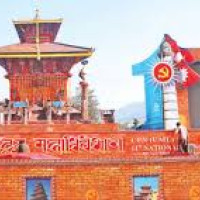- Friday, 19 December 2025
Once gateway to Everest Base Camp, Jiri can still be a tourism jewel
Jiri (Dolakha), Apr. 7: Jiri, in Dolakha district, was once considered the gateway to Everest Base Camp. Not anymore. But despite the emergence of newer, more accessible routes, it still remains a haven for those seeking a less crowded experience.
Surrounded by stunning landscapes, Jiri offers unravished beauty and cultural immersion to travellers seeking a peaceful path.
Jiri holds significant historical importance in tourism, serving as the traditional starting point for trekkers bound for Everest Base Camp before the construction of the newer route via the Lukla Airport.
The traditional Everest Base Camp Trek originates from Jiri, a seven to eight-hour drive from Kathmandu. En-route, travellers are treated to breathtaking scenery, whisper waters of the Bhote Koshi River. Adventure seekers can even indulge in bungee jumping on the river.
This historic trek, navigated by Tenzing Norgay Sherpa and Edmund Hillary in 1953, provides an opportunity to delve into the breath-taking landscape of the Khumbu/Everest region and immerse oneself in the vibrant culture of the Sherpa community, said BK Pradhan, a social worker from Dolakha.
The newly established Toni Hagen Ecological Park, situated just above the Jiri market, offers picturesque views of the Lincoln Market and stands as a captivating tourist spot. Dedicated to the memory of Swiss geologist and photographer Dr. Toni Hagen, the park seeks to enhance tourism while honouring Hagen's legacy and showcasing the region's natural splendour.
Nestled at Ramite Danda, the park contributes significantly to positioning Jiri as a prominent tourist destination, often dubbed “Nepal's Switzerland.” Its presence further enriches Jiri's charm, complementing other attractions such as Rambole Mahadev, Jireshwor Temple, and a Cheese Factory.
Mayor of Jiri Municipality, Mitra Jirel, said that the municipality has commenced the construction of tourism parks in all nine wards within its jurisdiction, primarily aiming to attract domestic tourists.
Toni Hagen Park is being developed in Ward No. 5, Stone Park in Ward No. 1, and Guru Padmasambhava statue is scheduled for completion within two years in Ward No. 2, which he claims will be the tallest in Asia. “We expect Buddhist tourists from around the world to visit the park,” he added.
The municipality is also initiating the construction of Jiti Lake, and a Detailed Project Report (DPR) has been prepared for Rs. 50 billion investment. Additionally, plans are underway for Gurans Park, Buddha Park, a View Tower, and Hanumante Danda (peak) to offer panoramic views of the Himalayas in the Gaurishankar range.
“We are prioritising agriculture and tourism in the area under the theme ‘Clean Jiri, Green Jiri, and Organic Jiri,’” he elaborated.
The Hagen Park, situated at Ramite Danda, encompasses five small peaks. From this park, tourists can behold the Lincoln Market and the Jiri Valley, which boasts mesmerising scenic beauty. A large Nepali flag adorns the park, adding to its attraction.
According to Jirel, Jiri is witnessing the development of several remarkable parks, each with its own unique significance. The Tenzing-Hillary Memorial Park, under construction, commemorates the overnight stay of the iconic duo before their historic Everest summit.
This park promises to be a tribute to their monumental achievement, he added.
The municipality is spearheading the creation of Haleshwar Park at Mali and Stone Park at Shyama, both of which hold archaeological and cultural importance. These parks aim to preserve precious stones and heritage for future generations, enhancing the region's cultural landscape.
The Toni Hagen Park, above 2100 metres above the sea level is abundant with various species of small wild animals, including rabbits and deer, along with wild fruits and flowers.
Pradeep Gaire, an officer at the Nepal Tourism Board, said that Jiri holds significant untapped potential for tourism. He underscored the necessity of employing traditional and organic methods to market the region effectively.
This likely entails leveraging local culture, heritage, and natural beauty to attract visitors, rather than relying solely on modern marketing techniques.
By embracing the authentic essence of Jiri and showcasing it in a genuine, organic manner, tourism in the area can thrive while preserving its unique identity and charm.

















